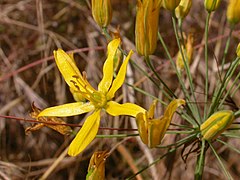Bloomeria
| Bloomeria subsp. var. | ||||||||||||||||||||||||||||||||||||||||||||||||||||||||
|---|---|---|---|---|---|---|---|---|---|---|---|---|---|---|---|---|---|---|---|---|---|---|---|---|---|---|---|---|---|---|---|---|---|---|---|---|---|---|---|---|---|---|---|---|---|---|---|---|---|---|---|---|---|---|---|---|

|
|
| ||||||||||||||||||||||||||||||||||||||||||||||||||||||
| ||||||||||||||||||||||||||||||||||||||||||||||||||||||||
Bloomeria, a geophyte in the Themidaceae, was named for H. G. Bloomer (1821–1874) an early San Francisco botanist. It consists of three species of California and Baja California.
| Standard Cyclopedia of Horticulture |
|---|
|
Bloomeria (named for Dr. H. G. Bloomer). Liliaceae. Small summer-blooming bulbous plants of the allium kind. A genus of 2 species, natives of S. Calif. In every way they are closely allied to Brodiaea, but differ in having the perianth parted nearly to the base. Bloomerias have a flattish corm, much like Crocus, covered with fiber, and not often producing offsets. The Lvs. are radical, slender, and grass-like: scape slender but stiff, 6-18 in. high, naked, except for short bracts beneath the many-rayed umbel; pedicels slender, jointed; fls. nearly rotate, less than an inch across, orange. Bloomerias prefer a sandy, warm and well-drained soil. In northern California, with a minimum temperature of 15° above zero, they are perfectly ' hardy. In a colder climate, a covering of straw or leaves or a position in the coldframe would be a judicious precaution. Plant early, and see that the soil is light and sweet. They like the sun, and are good for forcing. The light soil and warmth of a pot more nearly approximates natural conditions than the open ground does in cooler climates. After ripening, it is best to dig and replant in fall. The seeds grow readily, and the plants flower in three to four years.
|
Cultivation
- Do you have cultivation info on this plant? Edit this section!
Propagation
- Do you have propagation info on this plant? Edit this section!
Pests and diseases
- Do you have pest and disease info on this plant? Edit this section!
Species
- Bloomeria clevelandii S. Watson
- Bloomeria crocea (Torrey) Coville
- Bloomeria humilis Hoover
Gallery
If you have a photo of this plant, please upload it! Plus, there may be other photos available for you to add.
References
External links
- w:Bloomeria. Some of the material on this page may be from Wikipedia, under the Creative Commons license.
- Bloomeria QR Code (Size 50, 100, 200, 500)
